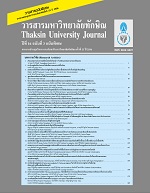การสกัดพอลิไฮดรอกซีบิวทิเรตจากเชื้อ Alcaligenes eutrophus ด้วยบรอมีเลนจากน้ำสับปะรด
Main Article Content
Abstract
การสกัดพอลิไฮดรอกซีบิวทิเรต จากเชื้อ Alcaligenes eutrophus ด้วยบรอมิเลนจากน้ำสับปะรด แบ่งออกเป็น สามการทดลอง โดยทาการศึกษาผลของอายุสับปะรดที่มีต่อกิจกรรมของเอนไซม์ การประยุกต์ใช้บรอมิเลนในการสกัด พีเอชบี และการยืนยันโครงสร้างพอลิเมอร์ด้วยเครื่องอินฟราเรดสเปคโตรสโคปี ผลการทดลองพบว่า น้ำสับปะรดจาก ผลที่มีอายุแตกต่างกัน (100-200 วนั หลังจากบังคับดอก) จะมีปริมาณโปรตีนในช่วง 98.7-123.46 มิลลิกรัม และมี กิจกรรมของบรอมิเลนในช่วง 1.41-1.64 ยูนิตต่อมิลลิลิตร โดยพบว่าปริมาณโปรตีนและกิจกรรมของเอนไซม์ไม่มีความ แตกต่างอย่างมีนัยสำคัญในผลสับปะรดที่ใช้ในการทดลอง เมื่อนำน้ำสับปะรดมาสกัดพีเอชบีจากเชื้อ A. eutrophus ที่ เลี้ยงในอาหาร Nutrient broth โดยมีกลูโคสความเข้มข้น 40 กรัมต่อลิตร เป็นแหล่งคาร์บอน จะได้พีเอชบีปริมาณ 1.57 กรัมต่อลิตร คิดเป็น 82.63 เปอร์เซ็นต์ต่อน้ำหนักเซลล์แห้ง จากการวิเคราะห์โครงสร้างด้วยเครื่องอินฟราเรดสเปคโตรส โคปีเปรียบเทียบกับพีเอชบีทางการค้าพบว่าพอลิเมอร์ที่ได้เป็นพอลิไฮดรอกซีบิวทิเรต
The extraction of polyhydroxybutyrate from Alcaligenes eutrophus by bromelain from pineapple juice
Piyaporn Wangsirigun1*, Nisa Paijit2, Tewan Yunu2, Kanokphorn Sangkharak3
The study of polyhydroxybutyrate (PHB) extraction from Alcaligenes eutrophus by bromelain from pineapple juice was separated into three experiments including the effect of pineapple age on enzyme activity, the application of bromelain for PHB extraction and the confirmation of isolated polymer by Infrared spectroscopy. The result revealed that pineapple juice from different age (100-200 days of cultivation) had protein content and bromelain activity in the range of 98.7-123.46 mg and 1.41-1.64 unit/mL, respectively. However, the content did not show the significant different. Pineapple age did not affected on protein content and bromelain activity. Therefore, pineapple juice was utilized for PHB extraction from A. eutrophus cultivated in Nutrient broth (NB) contained glucose (40 g/L) as carbon source. The extraction yielded PHB content at 1.57 g PHB /L with 82.63 % of dry cell weight (DCW). The structure of isolated polymer was confirmed by Infrared spectroscopy compared with commercial PHB. The structure indicated that isolated polymer was polyhydroxybutyrate.


